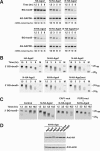CCR4-NOT deadenylates mRNA associated with RNA-induced silencing complexes in human cells
- PMID: 20065043
- PMCID: PMC2832495
- DOI: 10.1128/MCB.01481-09
CCR4-NOT deadenylates mRNA associated with RNA-induced silencing complexes in human cells
Abstract
MicroRNAs (miRNAs) repress gene expression posttranscriptionally by inhibiting translation and by expediting deadenylation so as to trigger rapid mRNA decay. Their regulatory influence is mediated by the protein components of the RNA-induced silencing complex (RISC), which deliver miRNAs and siRNAs to their mRNA targets. Here, we present evidence that CCR4-NOT is the deadenylase that removes poly(A) from messages destabilized by miRNAs in human cells. Overproducing a mutationally inactivated form of either of the catalytic subunits of this deadenylase (CCR4 or CAF1/POP2) significantly impedes the deadenylation and decay of mRNA targeted by a partially complementary miRNA. The same deadenylase initiates the degradation of "off-target" mRNAs that are bound by an imperfectly complementary siRNA introduced by transfection. The greater inhibitory effect of inactive CAF1 or POP2 (versus inactive CCR4) suggests a predominant role for this catalytic subunit of CCR4-NOT in miRNA- or small interfering RNA (siRNA)-mediated deadenylation. These effects of mi/siRNAs and CCR4-NOT can be fully reproduced by directly tethering RISC to mRNA without the guidance of a small RNA, indicating that the ability of RISC to accelerate deadenylation is independent of RNA base pairing. Despite its importance for mi/siRNA-mediated deadenylation, CCR4-NOT appears not to associate significantly with RISC, as judged by the failure of CAF1 and POP2 to coimmunoprecipitate detectably with either the Ago or TNRC6 subunit of RISC, a finding at odds with deadenylase recruitment as the mechanism by which RISC accelerates poly(A) removal.
Figures





Similar articles
-
Mammalian miRNA RISC recruits CAF1 and PABP to affect PABP-dependent deadenylation.Mol Cell. 2009 Sep 24;35(6):868-80. doi: 10.1016/j.molcel.2009.08.004. Epub 2009 Aug 27. Mol Cell. 2009. PMID: 19716330 Free PMC article.
-
The enzyme activities of Caf1 and Ccr4 are both required for deadenylation by the human Ccr4-Not nuclease module.Biochem J. 2015 Jul 1;469(1):169-76. doi: 10.1042/BJ20150304. Epub 2015 May 6. Biochem J. 2015. PMID: 25944446 Free PMC article.
-
mRNA Deadenylation Is Coupled to Translation Rates by the Differential Activities of Ccr4-Not Nucleases.Mol Cell. 2018 Jun 21;70(6):1089-1100.e8. doi: 10.1016/j.molcel.2018.05.033. Mol Cell. 2018. PMID: 29932902 Free PMC article.
-
Deadenylation of cytoplasmic mRNA by the mammalian Ccr4-Not complex.Biochem Soc Trans. 2012 Aug;40(4):896-901. doi: 10.1042/BST20120074. Biochem Soc Trans. 2012. PMID: 22817755 Review.
-
Cytoplasmic deadenylation: regulation of mRNA fate.Biochem Soc Trans. 2010 Dec;38(6):1531-6. doi: 10.1042/BST0381531. Biochem Soc Trans. 2010. PMID: 21118121 Free PMC article. Review.
Cited by
-
Combinatorial mRNA binding by AUF1 and Argonaute 2 controls decay of selected target mRNAs.Nucleic Acids Res. 2013 Feb 1;41(4):2644-58. doi: 10.1093/nar/gks1453. Epub 2013 Jan 8. Nucleic Acids Res. 2013. PMID: 23303783 Free PMC article.
-
The Importance of Protein Phosphorylation for Signaling and Metabolism in Response to Diel Light Cycling and Nutrient Availability in a Marine Diatom.Biology (Basel). 2020 Jul 6;9(7):155. doi: 10.3390/biology9070155. Biology (Basel). 2020. PMID: 32640597 Free PMC article.
-
Function and Regulation of MicroRNAs and Their Potential as Biomarkers in Paediatric Liver Disease.Int J Mol Sci. 2016 Oct 27;17(11):1795. doi: 10.3390/ijms17111795. Int J Mol Sci. 2016. PMID: 27801781 Free PMC article. Review.
-
Mathematical Modeling of mRNA Poly(A) Tail Shortening Process.Methods Mol Biol. 2024;2723:303-317. doi: 10.1007/978-1-0716-3481-3_18. Methods Mol Biol. 2024. PMID: 37824078
-
Novel roles of the multi-functional CCR4-NOT complex in post-transcriptional regulation.Front Genet. 2014 May 20;5:135. doi: 10.3389/fgene.2014.00135. eCollection 2014. Front Genet. 2014. PMID: 24904636 Free PMC article. Review.
References
-
- Bagga, S., J. Bracht, S. Hunter, K. Massirer, J. Holtz, R. Eachus, and A. E. Pasquinelli. 2005. Regulation by let-7 and lin-4 miRNAs results in target mRNA degradation. Cell 122:553-563. - PubMed
-
- Birmingham, A., E. M. Anderson, A. Reynolds, D. Ilsley-Tyree, D. Leake, Y. Fedorov, S. Baskerville, E. Maksimova, K. Robinson, J. Karpilow, W. S. Marshall, and A. Khvorova. 2006. 3′UTR seed matches, but not overall identity, are associated with RNAi off-targets. Nat. Methods 3:199-204. - PubMed
Publication types
MeSH terms
Substances
Grants and funding
LinkOut - more resources
Full Text Sources
Molecular Biology Databases
